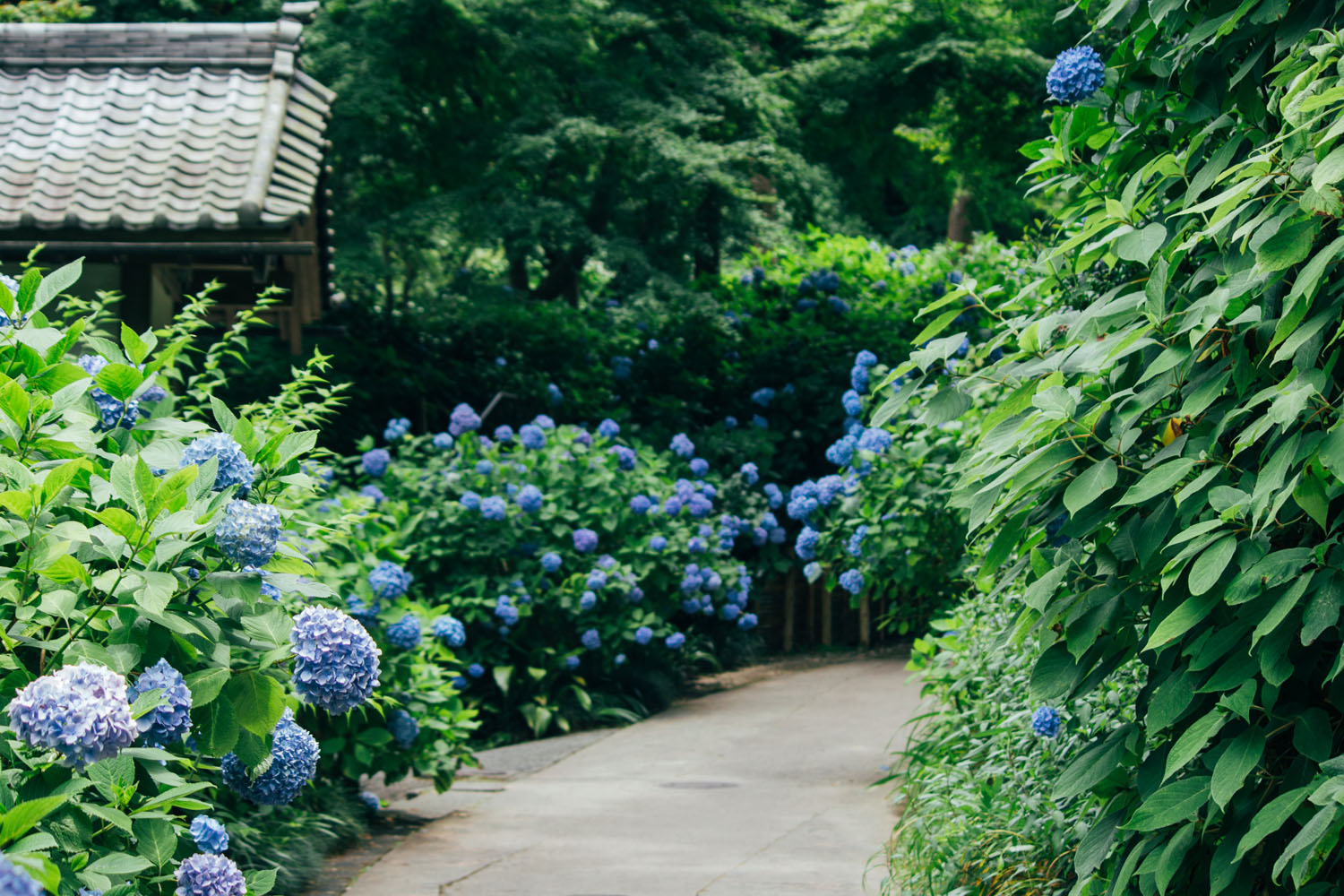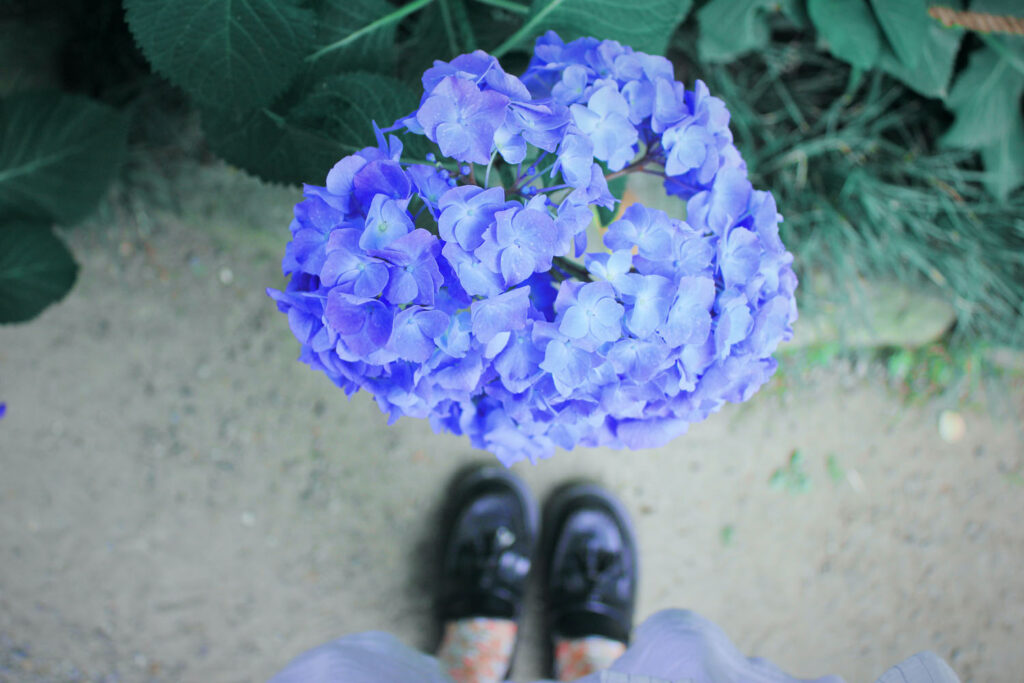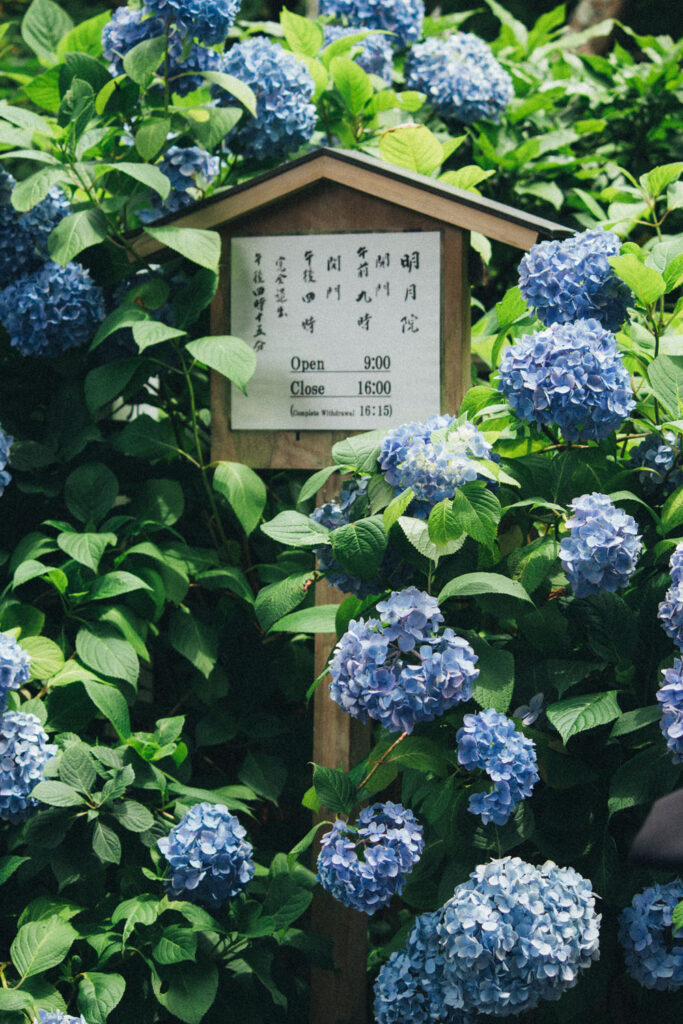

The rainy season in Kamakura brings with it the most beautiful spray of bright blue and purple hydrangeas! As the rain mixes with summer’s hot temperatures and humidity, it creates the ideal conditions for this flower to grow. Ajisai, as they are called in Japan, is grown all over the country. But Kamakura is the most popular place to see such a wide variety and concentration of them. Although a rainy day can seem like it could ruin your vacation, Japanese people think the opposite. It’s said that seeing the flowers in the rain is actually the best time to view them. So instead of letting the rain get you down, make your way to Kamakura and soak in the beauty of their hydrangeas.




The key to a great day out in the rain is the proper attire! If you know there might be rain on your trip, bring a light but high-quality raincoat with you. A coat that folds up quickly is great as it can be tucked away in your backpack once the rain passes. I always bring a large plastic bag with me to put any wet clothes inside once I take them off.
While you might not want to pack a large pair of rubber boots, an excellent option is all-weather leather ankle boots. Add a bit of anti-rain spray and this will go along way to keeping your feet dry. If I’m expecting a lot of rain, I always pack an extra pair of socks. Just throw them in your backpack to change into throughout the day. They take up almost no room and can be a game-changer. Avoid wearing jeans on a rainy day as once they get wet, they take FOREVER to dry! Avoid cotton and synthetic fabrics as well. The best thing to wear, especially in warmer weather, is a dress with nylon stockings or light leggings. Since these aren’t too porous, they won’t retain the water and dry quickly once the weather clears up.
If you’re hesitant to bring an umbrella, as it takes up weight and room in your suitcase, fear not! On rainy days, almost everywhere you go in Japan, like train stations and convenience stores, will have umbrellas for sale. And best of all, they only cost about $5. They are surprisingly high quality and even look super cute! I love the clear plastic dome and a wide opening for good rain coverage.
Hydrangeas are not only a beautiful flower but also a highly symbolic one. Since the flower has a large head and long stalk, the blooms appear to bow down as if they were crying when covered in rainfall. The pale pink varieties are thought to resemble the shape of a beating heart. So for these reasons, they have always been associated with heartfelt emotion. Legend has it that the Japanese emperor gave the hydrangea flower to the family of the girl he loved. He had been paying too much attention to work and not enough to her. He wanted to show his remorse to his future in-laws for his neglect. So he sent them a basket of flowers to show how sorry he was and express his gratitude for their understanding.
The variety of hydrangea that you’ll find in Japan was created by famous botanist Tomitaro Makino. He was known as the “Father of Japanese Botany.” He named this variety the “princess hydrangea” because of its large, beautiful clusters of star-like petals. As the flower blooms, the colours of the petals get deeper and deeper. When they first open, they are a pale, baby blue colour. As their seasons extend, the colour gradually turns into a deep indigo hue. One of the best times to view the flowers is at dawn and dusk. At this time the light of the rising or setting sun kisses the petals and makes them appear even more vibrant. For these reasons, they are also labeleld as ‘Shitihenge‘ flowers which means “various changes“.
Hydrangeas bloom in Kamakura from mid-June to early July. Rain or shine, the hydrangea season in Kamakura is hectic! Local Japanese people come from prefectures all over the country to see the flower – they definitely aren’t a hidden secret. The best times to avoid at all costs are the weekend and holidays when you’ll see the largest influx of people. Aim for an early start to your day and arrive mid-week and you’ll be rewarded with the best shot of having an excellent opportunity to see the flowers without too many crowds.
Remember, if there’s a large group gathered blocking your view, just wait till the group passes. You might find you suddenly have the spot all to yourself (if even for just a minute.) As in all things, patience is critical, as well as understanding that everyone else is just as excited as you to see the blooms, and we all just need to share the space.
Kamakura is a comfortable hour-long train ride from Tokyo, making it one of the easiest day-trips to do. If you leave from the central hub of Tokyo Station you can get right on the Yokosuka Line. This line arrives directly at our first stop, Kita-Kamakura Station. No need to change any lines. Virtually, from anywhere else in Tokyo you can still arrive quickly in Kamakura with generally just one change of trains.
Head to Kita-Kamakura Station to make your way to Engakuji temple. This temple complex is the best place to start your day. The hydrangeas here aren’t as dense as the other spots, so it’s one of the less crowded places on the tour. The Engakuji temple is one of the most important Zen Buddhist temple complexes in Japan. Its historical importance is one of the foundations of Kamakura but the beauty of the gardens and buildings that make up the temple complex is what will draw you in like under a spell.
Hours: 8:00 am – 4:30 pm | Admission fee: 300 yen
The hydrangea blooms pop-up in small clusters throughout the temple. Along the pathways and around the large Sanmon gate. Be sure to find the tea house located on the grounds. During the hydrangea season, you can enjoy a cup of matcha with a side of sweet candy shaped into the iconic blossoms.
Just across from Kita-Kamakura station and south down the road a few minutes, you’ll find yourself at Tokeiji Temple. Tokeiji Temple was founded as a nunnery for women who wanted to escape abusive marriages but could not initiate a divorce. Their flower garden was always one of the greatest in Kamakura, and still to this day, it’s a great place to come to see the hydrangeas.
Hours: 8:30 am to 5:00 pm | Admission Fee: 100 yen
Continue walking south and cross over the river when you come to Meigetsuin Street. Named for the most famous temple to see during the flower season. The road will be pretty busy as this narrow street, usually only for a few locals, is suddenly overcome with tourists. As you approach the mouth of the temple, you’ll see why…
Hours: 8:30 am to 5 pm (last admission at 4:30 pm) | Admission fee: 500 yen
Meigetsu-in Temple is also known as the “Ajisai-dera Temple“, which means “Hydrangea Temple“. Every year, baby blue hydrangeas bloom in the gardens which cover the grounds of the temple. One of the best views of the flowers is right as you come in. The sprays of blooms lean in on either side of the staircase. Almost greeting you with their bowed heads. Meigetsu-in was founded in 1160 as a Rinzai Zen temple and Buddist school. The temple complex provides a stunning array of views at the iconic Kamakura landscape. The views features a look at the valley with its low hills and bright green foliage spread across the background of the great mountains.
Meigetsu-in Temple is famously known for housing the tomb of Hojo Tokiyori, a former supreme ruler of Japan. Tokiyori made his home in Kamakura and wanted to be commemorated here. The building that houses his tomb is one of the most beautiful, with a charming thatched roof and stunning historical founders hall. The key feature of this room is the iconic circle window. The circle window is meant to resemble the moon as the name Meigetsu literally means “bright moon.” It is called the “Window of Enlightenment” and looks out at an inner zen garden where people can find peace in meditation.
As another nod to the moon, you might notice a series of rabbit statues throughout the temple. Rabbits have long been associated with the moon in Japanese folklore. Legend has it that when the man on the moon came down to earth, the rabbit was willing to sacrifice himself to feed the starving man. Shocked by the rabbit’s generosity, the man took the rabbit back to the moon with him. You can still see the outline of a rabbit pounding mochi on the full moon when you look up today. In addition to rabbit statues, there is also rabbit in cages that you’ll find as you explore. And you might even spot a rabbit hopping around the flowers as well.
Hase Temple or Hase-dera is known for its hilltop temple built into the mountains of Kamakura. But during the rainy season, what brings so many people to the temple are the 2,500 hydrangeas that cover the temple’s grounds. Over 40 different hydrangeas varieties bloom in the temple and cover the scenic Prospect Path, which looks over the seaside. The rising swell of flowers that cover the hills of the temple look like something out of a painting!
Hours: 8:00 am 5:00 pm | Admission fee: 400 yen
Walking down from Hase temple, make a stop at Joju-in Temple. This small temple is located at the top of long set of stairs, carved into the edge of the hillside looking out over the beach. The stone staircase is flanked by 262 hydrangeas that create this mesmerizing photo. One of the best parts of this stop is that you don’t even need to go into the temple to get the beautiful view! So it’s a free activitiy.
Gokurakuji Station is a charming little train station where you can see a smattering of hydrangea flowers located on either side of the train track. The flowers grow so large they lean onto the track, almost getting in the way of the train. Gokurakuji is located on the historic Enoden Train line famous for its retro and colourful train cars.
Although Gokurakuji Temple might be small, it has an impressive set of hydrangeas out front. These bright and elegant flowers look especially beautiful against the temple’s rustic backdrop.
Hours: 9:00 to 4:30 pm | Admission: Free
Once you are done touring the temple, it’s time to get something to eat. And there is no better place to eat the best street food than Komachi street. Just as Sakura’s seem to be a Japanese obsession, Kamakura residents love their hydrangeas. At Komachi Chaya, they serve up a hydrangea black tea infused with the petals. You can also get an ombre coloured kakigori inspired by the hues of the hydrangea. Traditionally a kakigori is either plain or covered in toppings. But this one is served with a tray of various fruit compotes on the side to pour on top as you like it! Adding the fruit as you eat it also means it doesn’t immediately melt the ice right away. The perfect treat to enjoy on a hot and humid day.
My favourite stop for a treat in Kamakura is Sakura no Yumemiya. This shop sells a variety of fantastic dango. Dango is Japanese dumplings made from rice flour. They are very similar to mochi, but the rice flour balls are smaller, the size of a marble, and steamed to make them super bouncy instead of chewy. While dango usually comes in just one of two flavours, this shop has dozens and dozens of toppings that jazz it up. The best one to get during this season is the hydrangea-inspired dango. It is covered in a green and purple topping meant to resemble the hydrangeas steams and flowers. The toppings are made from white bean paste. The green part is flavoured with matcha, while the purple is flavoured with taro (sweet potato).
Imoyoshi Yakata is a trendy and colourful soft serve ice cream shop. Other than the smiling faces of the people inside, the thing that really draws you into the shop is the fantastic flavours offered up here. But what you need to buy during hydrangea season is the “Ajisai” ice cream. This version is a mix of Uji green tea and purple sweet potato, once more coloured to look like the iconic flower.
If you find yourself anywhere near Kamakura during the rainy season you really need to make an effort to see the hydrangeas for yourself! The season isn’t as short-lived as the Sakuras, so you have a little bit more time to plan your trip around seeing them. They are definitely a popular attraction but well worth the train ride out to see them. Plus, Kamakura is one of my favourite day trips from Tokyo and such a lovely little seaside town to wander and explore.
Paris transforms into a magical wonderland from November to January, bursting with festive charm and…
French cuisine is one of the coziest delights to savour in winter. With its hearty…
During the festive season, Paris becomes a sparkling holiday dream, with twinkling fairy lights cascading…
When it comes to Christmas shopping, Paris is pure magic—a city where elegance meets holiday…
There’s nothing quite like Paris at Christmastime—the City of Light transforms into a glittering wonderland,…
There’s something undeniably magical about Paris at Christmas. Sure, the City of Light is enchanting…
This website uses cookies.